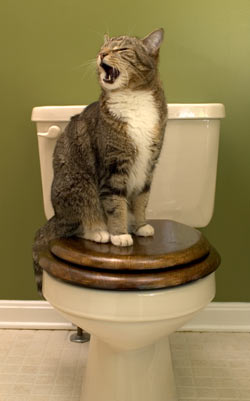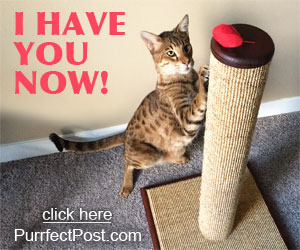General Tips for Solving Inappropriate Urination Problems in Cats

Inappropriate urination in cats can be a frustrating problem for both you and your feline friend. There are many reasons that cats may urinate in spots other than their litter boxes. Take a look at this article for an in-depth discussion of the problem. Below are some basic tips for solving this issue:
- Remember one basic rule of feline behavior: Cats can't be trained to use the litter box. They can only choose to prefer a litter box over another location.
-
It is often difficult to distinguish between location and substrate (litter type) aversions. If you are not sure which problem is causing your cat to urinate inappropriately:
- Try offering a variety of different types of litters, at different depths, in separate boxes that are placed next to each other.
- If your cat resumes using the box in the same location with a different litter material, then you will know that he exhibits specific litter type preferences.
- If the inappropriate urination continues, you can return to the initial litter type, but move the box to an altogether different location.
- Most cats prefer softer, finer-grained materials for litter, such as sand and clumping materials. Remember, though, that if your cat had a bad experience with one of these types of litter, he may associate that occurrence with the litter itself and avoid it in the future. If you suspect this may be the case for your cat, change to a differently-textured litter; for example, a clay product. You can also try Yesterday’s News
, which is made from recycled newspapers. Two other great products that are different textures are World's Best Cat Litter
and crystal litters like this one
.
- While treating any inappropriate elimination problem, it may be necessary to isolate the cat in a small room where no previous house soiling has occurred. It is imperative that you do not think of or treat this as a punishment. It is not; it is simply a way to try and reprogram your cat to use his box. Provide your cat with plenty of toys, love, and attention while he is in this room. Let him out only when 100% supervision is provided. You may wish to place a bell on his collar so you know where he is at all times. Hopefully, while he is restricted on space, he will redevelop good litter box habits. The amount of time that he will need to be isolated should be proportional to the length of time that the inappropriate behavior occurred; anywhere from one to four weeks is usually sufficient.
- If your cat is not using the box within the isolation room, provide a variety of different litters in a number of locations. Use different depths and types of litter. Provide different boxes — shallow, deep, wide open, covered, and partially covered. If your cat reveals his preferences, discard the boxes and litter types that he doesn't like.
- If you have multiple cats and one is harassing another, the meeker cat may develop an elimination location preference for the back of your closet, where the dominant cat doesn't follow him. Provide this cat with a safe place to eliminate. You may need to place a box in the closet, but you must ensure that the dominant cat doesn't stalk and corner the meeker one there. Sometimes placing a bell on the aggressor's collar will alert the more timid cat that his bully is near. Always remember to use breakaway collars on cats.
-
If your cat is exhibiting a definite location preference and continually urinates in the same inappropriate spot, there are several ways to solve the problem.
- First, you must thoroughly clean the soiled area.
- You can then place something over the spot, such as furniture or maybe your cat's food and water bowls, since many cats do not want to eliminate where they eat.
- If your cat comes back and urinates next to the obstacles, try placing a litter box in the area where he is eliminating.
- If he uses the box, don't make the mistake of moving it immediately. Leave the box in the exact position for 1-2 weeks. You may then begin to gradually move it 1 inch per day or so toward a more appropriate spot. You may even need to move it more slowly than this. It may seem like a small distance to you, but your cat will be very sensitive to the change.
- If you need to remove the litter box in order to host an event, then lock your cat in a room in which no inappropriate elimination has previously occurred. Supply him with his favorite box and litter, plenty of toys, food, water, and love. When it is possible to return the box to the previous spot, your cat may be released.
- If your cat is urinating right next to his box and you are sure that you're keeping it nice and clean, try a different type of litter.
- If there are several locations that are being used for inappropriate urination, place litter boxes at all of the locations, move furniture over them, or place food and water bowls there.
-
If your cat is using a potted plant as a litter box, there are several steps to stop this behavior.
- First, make the plant unappealing by placing wire mesh or aluminum foil over the soil. Large stones may be effective as well.
- You may need to use potting soil in the litterbox for a bit in order to encourage your cat to use the box.
- Once your cat is using the box, gradually start replacing the soil with the preferred litter.
- If your cat urinates next to the plant or still attempts to use the plant, then place the box next to it, filled with potting soil. Gradually replace the soil with litter, and then follow the above protocol of slowly moving the box to a more appropriate location.
The first step whenever your cat is urinating inappropriately is to visit the veterinarian. Medical conditions must be ruled out first before beginning behavior modification programs.
Punishment is never an effective solution! If you catch your cat in the act of urinating in an inappropriate spot and physically punish him, then throw him in the litter box, a more powerful litter box aversion is likely to develop. The only acceptable type of correction would be to startle your cat if you see that he is about to eliminate in an inappropriate spot. Either blowing a whistle or shaking a can filled with coins may be employed at the beginning of the behavior (when your cat is sniffing or scratching around) but not during the behavior (squatting and urinating). At that point, it is too late for the startling to have the desired effect.
Whereas punishment is not effective in cats, rewards are sometimes helpful. If you see your cat exhibiting the appropriate behavior by using his box, reward him with treats and praise (but don't startle him).
You can find tips for more specific litter box problems in the following articles:
Tips for Good Litter Box Placement
Tips for Good Litter Box Cleaning
Tips for Avoiding Litter Aversion in Cats
You May Also Like These Articles:
Inappropriate Urination in Cats
Tips for Good Litter Box Placement
Tips for Avoiding Litter Aversion in Cats
Tips for Good Litter Box Cleaning
Feline Lower Urinary Tract Disease
Giving Your Cat Clean and Fresh Water
Notice: Ask-a-Vet is an affiliated service for those who wish to speak with a veterinary professional about their pet's specific condition. Initially, a bot will ask questions to determine the general nature of your concern. Then, you will be transferred to a human. There is a charge for the service if you choose to connect to a veterinarian. Ask-a-Vet is not manned by the staff or owners of CatHealth.com, and the advice given should not delay or replace a visit to your veterinarian.





